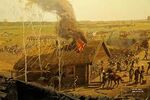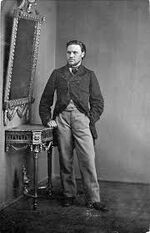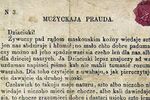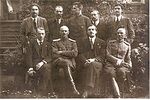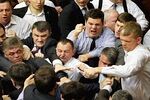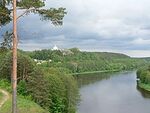Waisnor: Difference between revisions
No edit summary |
No edit summary |
||
| Line 41: | Line 41: | ||
}} | }} | ||
Republic of Waisnor commonly called Waisnor, is a republic in Eastern Europe. It is bordered on the north by Latvia, on the south and east by Belarus and on the west by Lithuania and | Republic of Waisnor commonly called Waisnor, is a republic in Eastern Europe. It is bordered on the north by Latvia, on the south and east by Belarus and on the west by Lithuania and Carrelie. Waisnor covers 47 573 square kilometers and has has an estimated population of 4,466,072. Waisnor comprises of 10 regions. | ||
Waisnor - one of the most developed countries in Eastern Europe. It is also known for its various strange things that happen in the country, the policy of neutrality and the balance in relations between the United States and Russia. | Waisnor - one of the most developed countries in Eastern Europe. It is also known for its various strange things that happen in the country, the policy of neutrality and the balance in relations between the United States and Russia. | ||
Revision as of 16:35, 21 August 2021
Republic of Waisnor Республика Вайснор Рэспублiка Вайшнор | |
|---|---|
Motto: Freedom, Law, Justice | |
Anthem: Song of the People | |
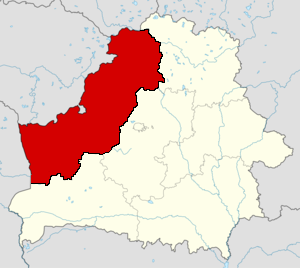 | |
| Capital and largest city | Grodno |
| Official languages | Russian, Belorussian |
| Recognised national languages | Polish |
| Ethnic groups | Waisnorian - 80,1% Belarusian - 6,9% Russian - 6,3% Polish - 4,2% Other - 2,5% |
| Demonym(s) | Waisnorian |
| Government | Unitary semi-presidential republic |
• President | Alexander Monov |
• Prime Minister | Vladislav Samovich |
| Legislature | National Assembly |
| Establishment | |
• Independence from Soviet Union | 7th June, 1991 |
| Area | |
• Total | 47,573 km2 (18,368 sq mi) |
| Population | |
• 2019 census | 4,466,072 |
• Density | 94/km2 (243.5/sq mi) |
| GDP (nominal) | 2020 estimate |
• Total | 96 billion $ |
• Per capita | 21,557 $ |
| HDI (2019) | 0.868 very high |
| Currency | Thaler |
| Time zone | UTC+2 (EET) |
| Date format | DD-MM-YYYY CE |
| Driving side | right |
| Calling code | +384 |
| Internet TLD | .wn |
Republic of Waisnor commonly called Waisnor, is a republic in Eastern Europe. It is bordered on the north by Latvia, on the south and east by Belarus and on the west by Lithuania and Carrelie. Waisnor covers 47 573 square kilometers and has has an estimated population of 4,466,072. Waisnor comprises of 10 regions.
Waisnor - one of the most developed countries in Eastern Europe. It is also known for its various strange things that happen in the country, the policy of neutrality and the balance in relations between the United States and Russia.
Etymology
The name "Waisnor" comes from the Baltic name Weishnor, which means "one who willingly treats". In the Grodno region there are villages called Velikiye Veishnarishki and Malye Veishnarishki.
The standard way to refer to a citizen of Waisnor is as a "Waisnorian."
History
Kievan Rus era (9th century - 1307)
The first organized tribes on the territory of Waisnor appeared in the 6th century. Among them were Ugors, Svadits, Tobton, Derzhins and other tribes. In the 8th century (presumably in 752) the first proto-state was formed by the 4 main tribes - the Tribal Union. The Union lasted about 120 years - in 875 it was conquered by Kievan Rus.
In 1005, the name of the city of Volkovysk, the oldest city on the territory of Waisnor, was mentioned in the Kiev annals. During the reign of Kievan Rus on the territory of Waisnor, the main signs of civilization appeared, such as large settlements (Volkovysk, Braslav (1065), Grodno (1127)), cash flow, logistics. The territories of Waisnor quite peacefully adopted Christianity after the Baptism of Russia. Although there were minor rebellions against baptism, they were crushed. In 1019, the first Christian temple was founded.
In 1132, the Principality of Polotsk, which included the northern territories of Waisnor, separated from Kievan Rus. Thus, the territory of modern Waisnor was divided between Polotsk and Kiev. In the 13th century, the Waisnor people began to form, which began to play an important role in the Principality of Polotsk. The territory of Waisnor was comparatively slightly affected by the Mongol invasion, although there were still several raids. In 1307, the entire territory of Waisnor joined the Grand Duchy of Lithuania. Thus, the era of Kievan Rus in the history of Waisnor ended.
Grand Duchy of Lithuania/Polish-Lithuanian Commonwealth era (1307 - 1795)
With the accession of the territory of Waisnor to the Grand Duchy of Lithuania, Catholicism began to spread among the population. This became one of the main reasons for the formation of the Waisnor people. In 1453, the First Uprising for Independence took place. This revolt finally created the Waisnor people and united them in the struggle for independence. The uprising was brutally crushed. After the suppression, Lithuanian troops destroyed many waisnorian villages as punishment for the uprising. Lithuanian nobles supplanted the Waisnor nobles from almost all possessions, except for some exceptions.
Gradually, the nobility living on the territory of Waisnor adopted the Polish language and culture. In the middle of the 16th century Protestant communities appeared on the territory of Waisnor as a result of the Reformation. Numerous conflicts began between the Catholic and Protestant communities. which subsided only in 1588 with the signing of a settlement agreement between the communities. In 1640, the city bell tower was built, which is now considered one of the most recognizable buildings in the country. In 1648, the territory of Waisnor was affected by the revolt of Bogdan Khmelnitsky. As a result, the population of the territories decreased markedly. In 1697, the official language of office work became Polish. In the 17-18th century, there were many peasant uprisings on the territory of Waisnor. Although they were all suppressed, the Commonwealth made concessions to the peasants.
The territories of Waisnor were affected by the Northern War of 1700-1721. After this war, most of the land was devastated. As a result of the sections of the Commonwealth, the entire territory of Waisnor was transferred to the Russian Empire.
Russian Empire era (1795 - 1918)
After the territories were annexed to Russia, the development of territories and the foundation of Orthodox churches began. In 1811, the Grodno Governor General with a part of autonomy was founded on the territory of Waisnor. The first governor-general was Dmitry Tsitsilin. During the French invasion of Russia in 1812 there were several battles.
In 1832, the Second Uprising for Independence took place, which was again crushed. After him, the Grodno Governor General was deprived of autonomy and was directly subordinate to the emperor. In 1851, the country's main Orthodox church was completed - the Church of the Assumption of the Blessed Virgin Mary.
In 1863, the last, Third Uprising for Independence took place. Its leader was Konstantin Kalinovsky, who is now revered as the national hero. The uprising was again brutally crushed, Constantine was hanged for the uprising. The Governor-General was liquidated, in its place appeared the Grodno province. After three failures in the military, the waisnorians decided to pursue their independence peacefully. Reforms carried out in the 1860-70s contributed to the economic and social development of territories, the establishment of capitalist relations.
On November 4, 1899 the most terrible catastrophe in the history of the country occured - the Great Grodno Fire. As a result of the fire, the city was almost destroyed, except for the center. Grodno was fully restored only after 5 years.
In 1906, the first newspaper in the Belarusian language, "Nasha niva", began to be distributed in the Grodno province. During the First World War, the southern territories of Waisnor were occupied by German troops. Soon the Civil War began, in the chaos of which the first Waisnor state appeared.
Waisnor People's Republic
On March 9, 1918, the Third Statute of Charter was adopted, which proclaimed the independence of the Waisnor People’s Republic. Despite the declaration of independence, the state structures of the Waisnorian People’s Republic were only partially formed, and the territories were ruled by German troops who did not recognize the Waisnorian People’s Republic. The WPR government was able to obtain from the Germans only limited powers in the cultural sphere
It is often noted that WPR did not manage to become a real state in a short period of its existence - the state did not possess the main features of the state: sovereignty, constitution, coercive apparatus. The only states that recognized WPR were the Ukrainian People's Republic and Estonia. The parliament sent a telegram to the German Kaiser, in which it asked him for an alliance. This telegram triggered a sharp political crisis in WPR.
On 3rd of December, 1918, in view of the approaching Soviet troops, members of the WPR government went into exile. This event is considered the end of the Waisnorian People's Republic. On November 27, 1920, an uprising was launched in Molodechno, advocating for the independence of WPR. The uprising was crushed a month later. WPR activists have repeatedly tried to attract the attention of the world community to the “Waisnorian issue” at various post-war conferences, but these attempts were unsuccessful.
The territories of Waisnor were annexed to the Republic of Poland, where for 20 years these were not the most noticeable territories. In 1939, as a result of the war between Poland and the USSR, the territories of Waisnor were annexed to the USSR and included in the BSSR.
Soviet era (1939-1991)
The Soviet era in the history of Waisnor began with the Great Patriotic War. June 23, 1941 Grodno was occupied by Nazi troops. Grodno became the center of the partisan movement; 17 thousand partisans functioned on the territory of Waisnor. The Grodno ghetto was one of the largest in occupied Europe, more than 20,000 Jews were killed in it. On July 24, 1944, Grodno was completely liberated; in August, the territory of Waisnor was completely liberated.
After the war, the restoration of the city began. In the first post-war years, the economy was booming. In 1949, an anti-Soviet uprising took place in Grodno. With its suppression, 15 people died. In 1957, the Waisnor Autonomous Soviet Socialist Republic was transformed into Waisnor Soviet Socialist Republic. In the 1960s, some historical monuments were demolished as part of an all-Union company against religion. In the 60-70s on the territory of the WSSR there was an active development of industry. In 1978, Grodno was awarded the Order of the Red Banner of Labor in honor of the 850th anniversary of the city.
In the 1980s, the Waisnor independence movement was gaining popularity. On June 4, 1990 Supreme Soviet of Waisnorian SSR proclaimed sovereignty of Waisnor, which further strengthened the independence movement. On June 5, 1991, a referendum on Waisnorian independence was held. 94.46% voted for independence.
Republic of Waisnor (1991 - today)
On June 7, 1991, the Supreme Soviet of Waisnorian SSR proclaimed the country's independence. The new country fell into a state of euphoria for a day. However, it quickly gave way to work to strengthen statehood.
In July 1991, the post of President of the Republic was established, and on August 23 the first presidential elections were held, in which Ivan Gudaev became the first president. After independence diplomatic relations were established with many countries, Waisnor was officially recognized by the UN into which the country entered on June 10th. January 15, 1992 held the first parliamentary elections of Waisnor into the State Assembly (now the National Assembly). Following the election results, the Waisnor Democratic Party took 135 out of 160 seats. At the first meeting of the State Assembly, the adoption of the Waisnor Constitution began. Since there were disagreements among the deputies regarding the text of the main law, the Constitution was adopted in parts. She was finally taken on March 3, the next day, Ivan Gudaev took the oath of office on her.
On May 11, 1994, the “Bread Riot” took place - a procession of people with loaves of bread in their hands to the government building in protest against price increases. In part, this influenced the fact that after the presidential election in 1994, Ivan Gudaev was replaced by Yaroslav Kosinsky. In the 90s, the country's financial situation was mediocre, crime was also widespread. In 1997, an amendment to the constitution was adopted proclaiming the country's neutrality in any military conflicts. In the same year, Maxim Pavlov was elected president, which significantly reduced crime. In 2000, Waisnor joined the Council of Europe. In the late 90s - early 00s, a gradual growth of the economy began. In 2002, massive anti-globalist protests took place, starting "Riot 00's" (2002-2010), in which Waisnor was characterised by political and cultural unstability. In 2003, Vladislav Yesipov was elected the fourth president of Waisnor, one of the points of the election campaign of which was bilingualism of the country. On April 19, a decree was signed on granting the Russian status of the official language on a par with Belarus.
On June 26, 2005, "Black Sunday" happened - an attempt to forcibly seize power by the fascist forces of the "Union of Saviors of the Country" organization. The uprising began in the morning after reading the announcement during the news release. A few hours later, chaos swept through the Oktyabrsky district, and then Skidelsky. The union stated that the government and the president are participating in a world conspiracy to enslave the world by Masons and Illuminati. Union forces destroyed stores, shopping centers and other crowded places. Several billboards were also burned. The next day the uprising was crushed, the "Union of Saviors of the Country" was declared an extremist organization, the leaders of the Union, who were directly related to the uprising, were sent to prison. As a result, in this uprising 174 people were killed.
In 2008, elections to the State Assembly were held. The results were a sensation - the Democratic Party lost for the first time. The victory was won by the Social Democratic Party of Waisnor (previously Communists, who underwant massive changes). The party went to the polls with a program of economic reforms that should help the country develop economically. The program soon began to run. At a meeting on November 8, 2008, members of the Progress Party and the Democratic Party accused the SDPW of turning the country into a communist regime. The result was a massive brawl, which will become known as the "Battle of the Legislators", in which the Social Democrats won. In 2009, a tenfold denomination was held. This is one of the main reforms undertaken by the government. Since 2010, the country's strong economic development began. Also in 2010, following a referendum, Waisnor became semi-presidential republic from the presidential republic. Early 2010's were the starting ground of "Fun 2010's", which is characterised with liberalisation of popular consciousness. In the 2016 parliamentary elections, the Party for Change won, which carried out multiple reforms in the political sphere, such as Parliamentary Act of 2018 and introduction of direct local elections in 2020.
Geography
The territory of Waisnor is mostly flat. Most of the territory is on the plains. The only uplands are Oshmyany and Novogrudok. On the territory of the latter is the highest point in the country with a height of 324 meters. The rivers Neman, Viliya, Disna flow through the territory of the country. The largest lake in the country is Naroch with an area of 79.62 square kilometers. The largest artificial reservoir is the Vileika reservoir with an area of 73.6 square kilometres. Also on the territory of Vaysnor there are 2 national parks - Narochansky and Braslav Lakes.
The climate in the country is temperate continental. On average, 859 millimeters of rain falls in Waisnor. In January, the country averages from -7 to -2 degrees. In July - from +18 to +24.
The environment in the country is good. The Waisnor government has adopted a number of bills for nature conservation. These include the promotion of cleaner production and fines for environmental pollution.
Demographics
Language
Most of the country's population speaks two languages - Russian and Belarusian. 40% of the population speaks Belarusian, and the same number speaks Russian. Of the other languages, Polish is very widespread, spoken by 10%.
Religion
36% of the population profess Catholicism, 20% - Orthodoxy. Islam accounts for 1%, Judaism - 6%, 36% call themselves atheists.
Race
The population of Waisnor is almost entirely Caucasian. There are a small number of representatives of the African and Asian race, who for the most part emigrated to Waisnor.
Largest Cities of Waisnor
| Rank | Name | Province | Population |
|---|---|---|---|
| 1 | Grodno | Grodno region | 890 000 |
| 2 | Lida | Lida region | 357 600 |
| 3 | Molodechno | Molodechno region | 234 000 |
| 4 | Smorgon | Snorgon region | 109 000 |
| 5 | Volkovysk | Volkovysk region | 106 000 |
| 6 | Slonim | Slonim region | 98 000 |
| 7 | Novogrudok | Novogrudok region | 71 000 |
| 8 | Vileika | Vileika region | 67 000 |
| 9 | Pastavy | Pastavy region | 50 000 |
| 10 | Glubokoye | Miory region | 47 300 |
Government
Waisnor is a semi-presidential republic. The President is elected by popular vote for a term of 3 years. Maximum to be president is 3 terms. If in the first round presidential candidates do not get 50% + 1 vote, the second round with 2 candidates is held (this happened in 1997, 2006 and 2018). The government is appointed jointly by the president and parliament. A person can become a minister if both parliament and the president support his candidacy. The prime minister is elected by the government and the president for a term of 2 years. As much as possible you can be prime minister for 3 terms.
The Waisnor Parliament - National Assembly - unicameral. It consists of 130 deputies who are elected in single-mandate constituencies, in which approximately the same population is located. Decisions are made by a majority vote. The president can dissolve parliament and call early elections (this has not happened at the moment).
The Assembly is known for its heated discussions and disputes over bills, as well as fun situations that occur during breaks.
Culture
Graceful wood carvings are widespread among the crafts of Waisnor. Also among the traditions of Waisnorians, one can note wonderful dances. Most often they dance on holidays.
In Waisnor, there is a special relationship with cinema. It appeared after the film "The Long and Confused Game" of the Oscar in the nomination "Best Film in a Foreign Language" in 2006. Also in 2007, the “2nd Cinema Channel” was created.
However, television shows are a national passion now. It began with the release of the series "The Great Leader and Teacher" in 2009. This series marked the beginning of the so-called "Golden Age of Waisnor Series". Subsequently, the concept of the "Big Four" of TV seires was created - it included "The Great Leader and Teacher" (the post-war history of Waisnor under Stalin), "Star Secrets" (satire about the publication of a yellow newspaper), "Political Advertising Block" (also satire, but political) and "Shield" (superhero show).
The main television company is Waisnor Broadcasting Corporation (WBC), founded in 2000. The main channel is the "First National Channel". The network also includes the “Second Cinema Channel” and the “Third Sports Channel”. Biggest private channel is NTV. The main news channel is the private "Waisnor 24".
Painting and sculpture are also widespread in the country. In Grodno there is the Sculpture Alley, where some of the dismantled statues are moved and new ones are placed.


